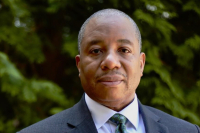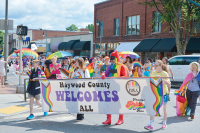Telling Appalachia’s untold stories: Artistic effort aims to celebrate the female side of history

Just as millennia of rain and wind and heat and cold have carved the physical shape of the mountains for which Appalachia is named, so have years of immigration and emigration and peace and war carved the human culture that covers them. Through the centuries, each of millions of lives — men and women, Cherokee and white, black and Hispanic — has added its own chapter to the story.
But the story is often told differently from the way it was written by the people whose lives were the lines, artist Mo Kessler told a group of people gathered for a March 28 panel discussion at the Museum of the Cherokee Indian.
“Appalachia is one of those places that is often told by outsiders, and it’s often wrong,” Kessler said. “We knew from the get-go we wanted to have an opportunity for people to tell their own stories.”
The story of Appalachia, said Kessler, who is from Kentucky, is often told through the lens of industry — logging, mining, factories. That tends to result in a masculine view of history.
Kessler, and other members of the Western Carolina University-based LIVLAB Artist Collective, hope to tell the feminine side of that story through a $50,000 grant they’re competing for from the Z. Smith Reynolds Foundation. The grant aims to fund a piece of public art that will raise up overlooked stories — to the LIVLAB members, stories related to the women of Appalachia seemed to fit the bill rather perfectly, especially when they realized the piece could be located at Dillsboro’s Appalachian Women’s Museum, another ongoing effort to tell the female side of Appalachian history.
SEE ALSO: Appalachian Women’s Museum anticipates pivotal year ahead
Related Items
“It was this awesome serendipitous moment of, ‘this is what we have to do,’” said Morgan Kennedy, assistant professor of sculpture at WCU and member of LIVLAB.
Leading up to the panel discussion, LIVLAB hosted two town hall meetings in Sylva to get an idea of what the community might want to see in a finished art piece. It will be located in the backyard of the museum building, centering around a big fire pit with bench seating circling the whole thing. The benches will contain technology allowing visitors to trigger a random database of stories of Appalachian women, “told by people who love them or know them or are them,” said Kessler. Ideally, they’d also be able to revamp some outdoor structure on the property as a recording studio for guests to add their own family stories.

Buena Hicks, of Watauga County, plays the fiddle while her sister Hattie Presnell looks on. Foxfire photo
“I was initially worried a little bit about a figurative kind of sculpture,” said Sharon Sullivan, president of the women’s museum board. “I just couldn’t see how it would fit, and they agreed. It wouldn’t. This is a walkway and enclosure and it’s very circular. It uses the look of the old native stone and the old native pointing. Its whole purpose is to engage, so I’m excited about it.”
LIVLAB was one of 20 applicants to win a preliminary $5,000 planning grant. A decision on the full grant amount is expected in May. If the funding comes through, build-out should take about a year.
Philosophy, religion and basketmaking
Before the stories can be told, they have to be known. That’s what the March 28 panel event, held at the Museum of the Cherokee Indian, was all about. Attendees were invited to share their own stories for incorporation into the finished piece, and the panel itself featured speakers from the Foxfire Museum, Macon County Women’s History Trail, Appalachian Women’s Museum and Cherokee Beloved Woman Committee.
“Our archive contains over 3,000 hours of audio interviews, 100,000 film negatives, tens of thousands of color slides, video. It’s remarkable. It’s daunting. And the vast majority of that material is women, I’m proud to say,” said T.J. Smith, executive director of Foxfire, a nonprofit based in Rabun County, Georgia, that works to document and preserve Appalachian heritage.
That’s not because Foxfire intentionally focuses on women, he said.
“I think it has a lot to do with the nature of the relationships between the (Foxfire) students and these people they interview,” he said. “Oftentimes when they would interview the men in the community it was very much focused on the task — how do you build a log cabin from scratch? How do you build a basket or a barrel? And that would be the gist of that interview.
“With the women they interviewed they got that stuff, because they interviewed people who were weavers and basketmakers, but they also got philosophy, they got religion, they got perspectives on community and family that the men were not willing to share or not inclined to share for whatever reason. There’s just a tremendous amount of the Appalachian ethos in those interviews. It’s quite remarkable.”

A window in the Appalachian Women’s Museum offers a view of the restored canning house. Holly Kays photo
That ethos is characterized by a recurring set of themes, said Smith.
“When I look at the interviews with women, there’s some focused thematic elements there,” he said. “There are a lot of great perspectives on some big ideas, community chief among them, work and work ethic and the importance of work, a lack of interest in material things and really just minimizing how non-important that stuff is. Strength through hardship, and also the relationship that they had with the land and nature around them.”
“Aunt” Arie Carpenter, who lived in the Otto community of Macon County, is one of the first people who comes to mind when Smith thinks about all the stories Foxfire has told over the years. Carpenter’s life was even written up as a Foxfire biography, and turned into a Broadway play and later a Hallmark movie. During her life, 1885-1978, she never traveled further than 35 miles from home and lived most of her married life, which began at age 38 after years spent caring for her mother, in a log house making a living off a small farm.
“The students would go to Aunt Arie’s house,” said Smith. “She would always cook for them, a full supper. She would sit with them and share with them as long as they wanted to stay with her. It was the favorite place for students to go.”
But Carpenter, Smith said, is “the tip of the iceberg” when it comes to admirable Appalachian women.
Lineage of power
Cherokee women were the first Appalachian women, and theirs is a story that tribal member Kimberley Smith — no relation to T.J. Smith — wants to see told.
Kim Smith was 29 when she first began learning about the women pivotal to her tribe’s past. She’d often driven by the tribe’s finance building, which is named after Beloved Woman Maggie Wachacha, but never knew who Wachacha was and what she did to get her name on the sign. She decided to start researching.
Now she knows that Wachacha was a Tribal Council clerk and Cherokee language speaker who lived in the remote Snowbird area of Graham County. Every month, she would walk 50 miles into Cherokee to serve as the language translator for Council.
“I hate to drive that far, and she walked, monthly, dedicating her time to be here to ensure that her community had a voice and her culture was preserved,” said Kim Smith.
The stories are compelling in their own right, but it’s important to look at them within the context of Cherokee culture, said Kim Smith. Unlike Western culture, traditional Cherokee culture was matrilineal but egalitarian. That means that lineage was traced through women rather than men but that the balance of power was equal between the genders.

The kitchen in the Appalachian Women’s Museum offers a peek into the early 1900s. Holly Kays photo
“Traditionally we were very balanced. We recognized the balance of the cosmos, so winter to summer, animals to plants and men to women,” she said. “There were very strong definitions for what a man is or what a woman is and what their duties are like.”
Women worked in agriculture and took care of the home, while men hunted and fought wars. Occasionally, women would cross those boundaries and go to war, with some of those warrior women earning a deep respect from their tribe for their contributions. When men tried to assume a different role, it didn’t work out the same way.
“It often seemed disrespectful that a man would try to live his life as a woman, because he could never complete all the activities a woman could,” said Kim Smith. “He could never menstruate, he could never bear a child.”
The words of Katteuha, a Cherokee woman who sent a letter to then-Pennsylvania Governor Benjamin Franklin arguing against further encroachment on Cherokee land, provide a strong example of the contrast between Western and Cherokee ideas of a woman’s place in the 18th century.
“I am in hopes that if you rightly consider it that woman is the mother of all and woman does not pull children out of trees or stumps nor out of old logs, but out of their bodies, so that they ought to mind what a woman says and look upon her as a mother — and I have taken the privilege to speak to you as my own children, and the same as if you had sucked my breast,” she wrote in 1787.
“It showed incredible leadership and incredible power that she possessed to be able to speak that way,” said Kim Smith.
As Western attitudes percolated more and more through traditional society, that perspective shifted. Older accounts showing pictures of Cherokee people tend to name the men in the images, while images of females are labeled more generically, as “image of Cherokee woman with child” or something similar, said Kim Smith.
“You always get this ‘Come to Cherokee, see the exotic Cherokee woman’ — you don’t really get to hear her story,” said Kim Smith.
That’s what she’s trying to change with some of her recent efforts, which include spearheading creation of the Beloved Woman Committee to better define the process for bestowing the title and celebrate those who have already received it. Smith’s research has turned up countless stories of bravery, wisdom and stoicism that she hopes to share with an ever-wider audience — and especially with her own daughters.
There is no shortage of stories. There’s Lula Owl Gloyne, for example, who is believed to be the first Native American registered nurse. She once saved a patient in Cherokee whose guts had spilled out of him and drove him 45 minutes to the nearest hospital — and then went to Washington, D.C., to advocate for Cherokee to get its own hospital.
Wilma Mankiller was the first female chief of either Cherokee tribe, Arizona Swayney was a college graduate and college professor in a time when neither was typical for a woman, and Ruth Littlejohn was a successful hotel owner in the 1950s, using her own money to start the fall festival that continues in Cherokee to this day.
By knowing the stories, Kim Smith said her daughters — and, hopefully, females throughout the tribe — “can be comfortable in their own skins and know they have a lineage of strong, independent women, and they’re not having to wait until 29 to find out about them.”

Beulah Perry stands in her yard in Rabun County, Georgia. Foxfire photo
Women from away
For Barbara McRae, a different kind of story hits home.
The child of an Air Force family, McRae didn’t grow up in Western North Carolina. She moved to Franklin with her husband in 1973, becoming a reporter for The Franklin Press and, later, its editor. Now retired, she serves on the town council and led efforts to create the Macon County Women’s History Trail, the first such trail in North Carolina.
“I’ve discovered a lot of very fascinating women, and some themes that I’ve come across that kind of surprised me,” she said. “One has to do with women from away.”
White settlers first arrived in Macon County around 1820. The people who came were children of the frontier, following the western front as it moved. Most of them were related to each other or otherwise knew each other, McRae said, so they brought a culture with them. By 1830 there were 2,300 settlers.
But in the 1830s, a lot of people left North Carolina for the promise of cheaper and more abundant land westward. Hardly anybody else moved in.
“Especially in the coves, you did have this beautiful culture that we think of as the Appalachian culture,” said McRae. “In the towns things were a little bit different. People were more literate, for one thing.”
Literacy was a problem. Before the Civil War, the area had public schools, but that system was destroyed in the conflict. Nearly all the schoolteachers had been male, and few of them were left after the war. By 1870, hardly anyone could read or write.
“The answer was to get women to go into teaching, and there was an organization called the Peabody Foundation,” said McRae. “His idea was to save the South by helping the South re-establish its education system. He figured the best way to do this was to get women to go into teaching.”
Society in Macon County was receptive to the idea. The wealthier families in town were “very interested” in educating their daughters, often sending them to Asheville for college or finishing school, said McRae. Various mining and forestry operations were headquartered in Franklin, attracting a set of educated, administrative people to town. The women spent their time as active members of various social and educational clubs, planning all sorts of events and programs in town.
Peabody helped start a teaching school and recruited women to go, and by the 20th century nearly all the teachers were women, a complete changeover from what had been.
“Of course a lot of the people who came into the county to teach, they came from somewhere else, and they were welcomed because they were so needed,” said McRae.

Eloise Potts (left) was the first director of the Macon County Department of Welfare and Franklin’s first female mayor. Mary Lapham (right) was a Highlands physician who pioneered what became a standard treatment for tuberculosis. Donated photos
Some women even made it into academic administration. Mary Kilgore, a young woman from Atlanta, was recruited as a teacher in 1919. But when the principal at the Higdonville high school where she taught left — his name was Robert Madison, and he left to start what would become Western Carolina University — she became the principal. Kilgore stayed for a year and then went to Iotla, where she worked for five years as a teacher and principal before returning to Atlanta, but she stayed connected to her community in Macon County.
“I interviewed this woman in 1980,” said McRae. “She came to Franklin to stay with friends she had kept up with all those years.”
Women were influential in other fields as well.
Mary Lapham, originally from a wealthy Midwestern family, moved to Highlands shortly after it was established, bought a farm as a single woman, and, upon discovering how little health care was available in the area, went to medical school and then to Switzerland to study the latest treatments for tuberculosis.
“Tuberculosis was the big killer in those days,” McRae said. “It’s incredible how many people died of it. She came back to Highlands and established a sanitarium. It was called Bug Hill. She had this treatment she had developed based on what she learned. It became the national norm and she became a nationally known figure. Hundreds of people came to the sanitarium, and she cured them.”
For McRae, the story of Arabella Johnson perhaps hits home the most. A widowed woman with six sons, Johnson bought the Franklin Press and ran it during World War II, becoming its first female editor. McRae was the second, and today she lives in the house Johnson once inhabited.
“I’ve really learned how much my experience in Macon County mirrored the example of these women that I have become so fond of in my research here,” said McRae. “People welcomed me with open arms when I came to Franklin. They got me into these clubs. They’re doing the same thing in 1973 that they were doing in 1920.”
Follow LIVLAB
Get updates on the LIVLAB project at the Appalachian Women’s Museum at www.facebook.com/WCU-Livlab-2041377835930866, www.instagram.com/wculivlab and bit.ly/2PcJJaa.









